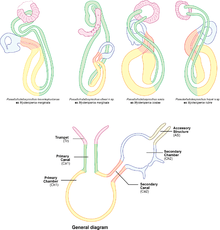Pseudorhabdosynochus beverleyburtonae
| Pseudorhabdosynochus beverleyburtonae | |
|---|---|
_-_FIGS_137-144.tif.jpg) | |
| Body and sclerotised parts | |
| Scientific classification | |
| Kingdom: | Animalia |
| Phylum: | Platyhelminthes |
| Class: | Monogenea |
| Subclass: | Monopisthocotylea |
| Family: | Diplectanidae |
| Genus: | Pseudorhabdosynochus |
| Species: | beverleyburtonae |
| Binomial name | |
| Pseudorhabdosynochus beverleyburtonae (Oliver, 1984) Kritsky & Beverley-Burton, 1986 | |
| Synonyms | |
|
Cycloplectanum beverleyburtonae Oliver, 1984; Diplectanum americanum of Euzet & Oliver (1965); Cycloplectanum americanum (Price, 1937) Oliver, 1968 (pro parte) | |
Pseudorhabdosynochus beverleyburtonae is a diplectanid monogenean parasitic on the gills of the Dusky grouper, Epinephelus marginatus.[1] It has been described by Guy Oliver in 1984[2] as Cycloplectanum beverleyburtonae, redescribed by Oliver in 1987,[1] transferred to the genus Pseudorhabdosynochus by Kritsky & Beverley-Burton in 1986[3] as Pseudorhabdosynochus beverleyburtonae, redescribed by Kritsky, Bakenhaster and Adams in 2015, [4] and redescribed in 2016 by Chaabane, Neifar, Gey & Justine. [5]
Description

Pseudorhabdosynochus beverleyburtonae is a small monogenean, 0.5-1 mm in length. The species has the general characteristics of other species of Pseudorhabdosynochus, with a flat body and a posterior haptor, which is the organ by which the monogenean attaches itself to the gill of is host. The haptor bears two squamodiscs, one ventral and one dorsal. The sclerotized male copulatory organ, or "quadriloculate organ", has the shape of a bean with four internal chambers, as in other species of Pseudorhabdosynochus.[3] The vagina includes a sclerotized part, which is a complex structure.
Pseudorhabdosynochus beverleyburtonae was redescribed from Museum specimens and new collections from off Tunisia by Chaabane, Neifar, Gey & Justine,[5] who proposed to erect a "beverleyburtonae group" for species who share common characteristics with it, including similar sclerotised vaginae and squamodiscs, and host groupers belonging to the genus Mycteroperca in the Mediterranean and the eastern Atlantic. These species are P. sosia Neifar & Euzet, 2007, P. hayet Chaabane, Neifar, Gey & Justine, 2016 and P. oliveri Chaabane, Neifar, Gey & Justine, 2016.
Etymology
According to Oliver (1984),[2] Pseudorhabdosynochus beverleyburtonae was named in homage to Dr Mary Beverley-Burton from the University of Guelph (Ontario, Canada).
Hosts and localities
The type-host and only recorded host of Pseudorhabdosynochus beverleyburtonae is the Dusky grouper, Epinephelus marginatus (Serranidae: Epinephelinae), which was designated as Epinephelus guaza in the original description by Oliver.[2] The type-locality is Côte Vermeille (Mediterranean Sea, France).[2] The species has also been recorded from the same host off Tunisia.[5]
Pseudorhabdosynochus beverleyburtonae is one of the few Monogeneans recorded from both sides of the Atlantic Ocean;[6] it was found on its type-host, Epinephelus marginatus, off Brazil.[4]
Gallery
 Vagina
Vagina Male copulatory organ and squamodiscs
Male copulatory organ and squamodiscs Phylogenetic relationships
Phylogenetic relationships
References
- 1 2 Oliver, G. (1987). Les Diplectanidae Bychowsky, 1957 (Monogenea, Monopisthocotylea, Dactylogyridea). Systématique. Biologie. Ontogénie. Écologie. Essai de phylogenèse. Thèse d'État, Académie de Montpellier, Université des Sciences et Techniques du Languedoc, France. doi:10.6084/m9.figshare.1295274

- 1 2 3 4 Oliver, G. 1984: Description de deux nouvelles espèces du genre Cycloplectanum Oliver, 1968 (Monogenea, Monopisthocotylea, Diplectanidae). Annales de Parasitologie Humaine et Comparée, 59, 31-39.
- 1 2 Kritsky, D. C. & Beverley-Burton, M. 1986: The status of Pseudorhabdosynochus Yamaguti, 1958, and Cycloplectanum Oliver, 1968 (Monogenea: Diplectanidae). Proceedings of the Biological Society of Washington, 99, 17-20. PDF

- 1 2 Kritsky, Delane C.; Bakenhaster, Micah D.; Adams, Douglas H. (2015). "Pseudorhabdosynochus species (Monogenoidea, Diplectanidae) parasitizing groupers (Serranidae, Epinephelinae, Epinephelini) in the western Atlantic Ocean and adjacent waters, with descriptions of 13 new species". Parasite. 22: 24. doi:10.1051/parasite/2015024. ISSN 1776-1042. PMC 4536336
 . PMID 26272242.
. PMID 26272242. 
- 1 2 3 Chaabane, Amira; Neifar, Lassad; Gey, Delphine; Justine, Jean-Lou (2016). "Species of Pseudorhabdosynochus (Monogenea, Diplectanidae) from groupers (Mycteroperca spp., Epinephelidae) in the Mediterranean and Eastern Atlantic Ocean, with special reference to the 'beverleyburtonae group' and description of two new species". PLOS ONE. 11 (8): e0159886. doi:10.1371/journal.pone.0159886. ISSN 1932-6203.

- ↑ Chaabane, Amira; Justine, Jean-Lou; Gey, Delphine; Bakenhaster, Micah D.; Neifar, Lassad (2016). "Pseudorhabdosynochus sulamericanus (Monogenea, Diplectanidae), a parasite of deep-sea groupers (Serranidae) occurs transatlantically on three congeneric hosts (Hyporthodus spp.), one from the Mediterranean Sea and two from the western Atlantic". PeerJ. 4: e2233. doi:10.7717/peerj.2233. ISSN 2167-8359.
